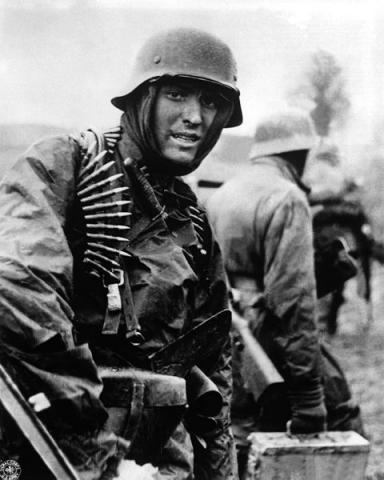The Battle of the Bulge Begins: December 16, 1944

In World War Two’s waning days, during the fall of 1944, Adolf Hitler ordered up one last role of the dice designed to stave off final defeat. This plan sought to punch through the densely forested, hilly, but lightly guarded Ardennes and reach Antwerp – thereby cutting off numerous Allied armies in a massive pocket similar to what his armies had accomplished four years prior.
German plans called for Sepp Dietrich’s Sixth SS Panzer Army to lead the assault through the Ardennes; as the northern army of the three German assault army’s. Dietrich first needed to seize Eupen, Stavelot, and Vevries so he could establish a strong defensive shoulder for the drive west. Just to the Sixth SS Panzer Army’s south, was Hasso von Manteuffel’s Fifth Panzer Army that first needed to take the important road junctions of Bastogne and St. Vith. After crossing the Meuse River near Namur, the Fifth Panzer Army was to provide support and protection for the SS spearhead’s southern flank. The panzer army’s deployed a combined armored strength of 900 tanks and 200 self-propelled guns. The all infantry Seventh Army under General Eric Brandenburger provided flank protection for the southern shoulder of the offensive. All told the German assault force was over 20 divisions strong, including seven panzer divisions, from 28 total divisions earmarked for the offensive. In spite of its size, the assault armies assembled largely concealed from the mostly unsuspecting Allies. Therefore, only four thinly spread infantry divisions in the Ardennes held the line for the Americans. The Germans enjoyed overwhelming local superiority in all arms, if not in logistics, time and leadership. As to the latter point, Hodges, commanding the First Army, and Patton, later to play a key role in the battle, ranked as far better officers than Dietrich. On the other hand, the advantage the Germans enjoyed in achieving near absolute surprise gave them a chance. It was with this chance that the German counteroffensive began early on the cold morning of December 16, 1944.
The Americans were quickly forced to give ground with many of the early retreats turning into a rout. German success proved ephemeral however, especially for the Sixth SS Panzer Army as Dietrich committed several fundamental errors. For one, he allowed his spearheads to bog down, and endured repeated stiff fights against the American infantry who bought time for reinforcements to pour into the area. In particular, one platoon from the 394th Regiment of the US 99th Infantry Division, ensconced in the village of Lanzerath, fought off a series of desperate German assaults, launched by elements of the German 3rd Parachute Division. It became the most decorated American platoon for a single action during the Second World War.
Meanwhile, on December 17th Brigadier General Bruce Clarke’s Combat Command B, from the American Seventh Armored Division, met the 1st SS Panzer Division on the approaches to the critical communications crossroads at St. Vith, ten miles behind the original allied front lines. During eight days of fierce combat the American armor, surviving elements from the 106th Infantry Division, and a hodgepodge of independent units held off multiple German assaults. Eventually, however, the Germans forced the Americans to withdraw, but only after the GI’s had completely upset the German timetable. In response Model shifted the offensive’s weight to the Fifth Panzer Army that by the night of the 17th had penetrated 20 miles. Nevertheless, Allied reinforcements streamed toward the fighting, including Patton’s headquarters staff and an entire corps pulled from the line well south of the Ardennes and wheeled north. A feat a German panzer corps would have been hard-pressed to accomplish at this stage in the war. Within days, over 60,000 reinforcements had arrived in the U.S. First Army’s area of operations. These men included the elite US 82nd and 101st Airborne Divisions. Ordered to hold the vital road junction at Bastogne, a mixed bag of encircled airborne and armored troops further delayed the German push west.
Then, on December 23rd the skies cleared. Allied aircraft pounded German forces as they ground ahead to reach within four miles of the Meuse River on December 26th. Nevertheless, relentless air attacks, lack of fuel and the defensive efforts led by the American 2nd Armored Division and 84th Infantry Division brought the Germans to a screeching halt, and the American 2nd Armored Division almost completely annihilated the German 2nd Panzer Division. Also on December 26th a relief column led by Lieutenant Colonel Creighton W. Abrams 37th Tank Battalion from the 4th Armored Division had lifted the German siege against Bastogne. Meanwhile the American 3rd Armored Division stopped the German 2nd SS Panzer Division east of Namur.
Hitler’s great counteroffensive had failed, though it would take until January 28, 1945 for the Allies to regain the ground lost to the Germans. Hitler’s counterattack in the Ardennes had cost him his strategic reserves - 100,000 casualties against 81,000 American and 1,400 British casualties. The Luftwaffe lost nearly 1,000 aircraft and the panzer divisions lost 800 tanks. For their part, the Americans had lost 730 tanks and tank destroyers. Hitler had gambled with his strategic reserves and lost.



Post new comment